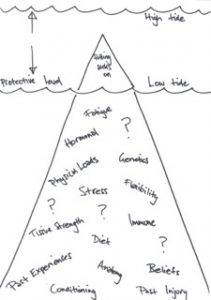Can your back ‘go out’?
No. This is the simplest, and most honest, answer.
People often explain their pain as ‘my back has gone out’. This would imply a structural deformation, like, for instance, a shoulder dislocation. A shoulder dislocation is a medical emergency that often requires relocation under anaesthetic and can have long-term implications.
Perhaps if you have suffered severe trauma you could dislocate a spinal segment. This would be a catastrophic injury, likely paralysing you. Luckily the spine is incredibly strong and resilient, and this would need a huge amount of force to create such a scenario.
However, acute, disabling back pain often occurs without trauma, and the trigger maybe something as trivial as putting your socks on, bending, turning, or just getting out of bed.
In all of these scenarios there is very little force going through the body and, indeed, we have probably achieved all of these actions thousands of times without injury or pain. So, it can be assumed we have not structurally damaged our body when these painful events occur.
A clinician’s first priority in addressing any pain is to rule out true pathology and tissue damage like infection, fracture, dislocation, ligament or muscle tear, tendon injury, hard neurological signs, cancer etc. If these more serious conditions can be excluded, then the pain can broadly be placed in the category of non-specific pain. Meaning that there is no specific pathology. This is a broad church, as the vast majority of presentations manual therapists see fit into this category.
So what causes non-specific pain?
Let me share a personal experience. Several weeks ago I was putting my socks on when I experienced sharp lower back pain and dropped to the floor. Trying to rise off the floor or later from a seated position or bending was restricted and painful.

The pain was intense and certainly did its job in alerting me to a possible threat. But as this has happened many times before, and I had known it to resolve over several days with treatment and other strategies, I knew I was dealing with non-specific pain, and not with tissue damage.
The trigger in this situation was very clear, and yet, surely something as trivial as bending to put socks on should not pose a threat to my body.
I thought back on the days and weeks leading up to this event. I had been sick the week before. I had been under stress with several things. My four-year had just started kinder and, with the transition, his behaviour had been challenging. I had been wrestling with my kids the days before and landed on my back a little awkwardly. These were just some of the conscious threats that I could identify. Yet, there would be many more unconscious factors that my body was processing on a cellular or systemic level.
My point is that anything that may be interpreted at a conscious or unconscious level as a threat may contribute to the sensitivity of our system in protecting us. Sometimes this protection occurs on a physical, or musculoskeletal level, as pain. Once triggered, this pain reaction may well cause local physical changes in muscle, immune cells (inflammation) and nerves.
The response is designed to protect our bodies by alerting us to potential threat and limiting further movement. The problem is that this reaction can sometimes be devastating and debilitating in response to very little, or no, credible threat. Meaning, the body gets it wrong.
However, the pain and physiological changes are as real as if you had broken a bone. Getting a treatment at this point will help calm things down. Moreover, understanding the nature of non-specific pain is likely to reduce stress and further improve recovery time.
I would explain my experience with an analogy. Putting my socks on was the ‘tip of the iceberg’ that we can clearly see above the water. Yet what is in the body of the iceberg, hidden below, may be just as important.

All possible threat/danger messages are unconsciously changing the tide level in this analogy. Fortunately for me, putting my socks on is nearly always an easy function! Meaning the tide is high enough for me to smoothly sail over this imaginary iceberg. Annoyingly, it seems impossible to accurately know when the water level drops to high alert. There are just too many unknowns.
The good news is that these experiences are not harmful and do not represent true danger or tissue damage. Usually we will recover from these events fairly quickly with the right management and an understanding of non-specific pain.
How we respond to them though is crucial. If we feel like we are the Titanic catastrophically hitting the iceberg, we will only further ramp up our pain response.

The problem is that pain provides the perfect environment for anxiety to flourish and each time we encounter it we may find it hard to believe that there is nothing structurally wrong.
Seeing a good health practitioner to rule out more serious injury is a crucial start. Manual therapy can help calm down a protective reaction. Developing rehabilitation strategies including mobility and strength is a good next step. Developing a path to increase capacity, movement and load tolerance will improve confidence for the future. Yet it is also important to identify and address other factors that may be sensitising your system (i.e. stress, fatigue, psychological, immune and hormonal factors etc.). This is a holistic and preventative approach.
The reason I feel strongly about this approach is that if we are told something is ‘out’ and all we need to do is ‘put it back in’, it is disempowering and encourages a passive, and indefinite, approach. Changing our understanding of pain to a more scientifically-informed perspective can lay the foundation for an empowered, active and sustainable approach.



